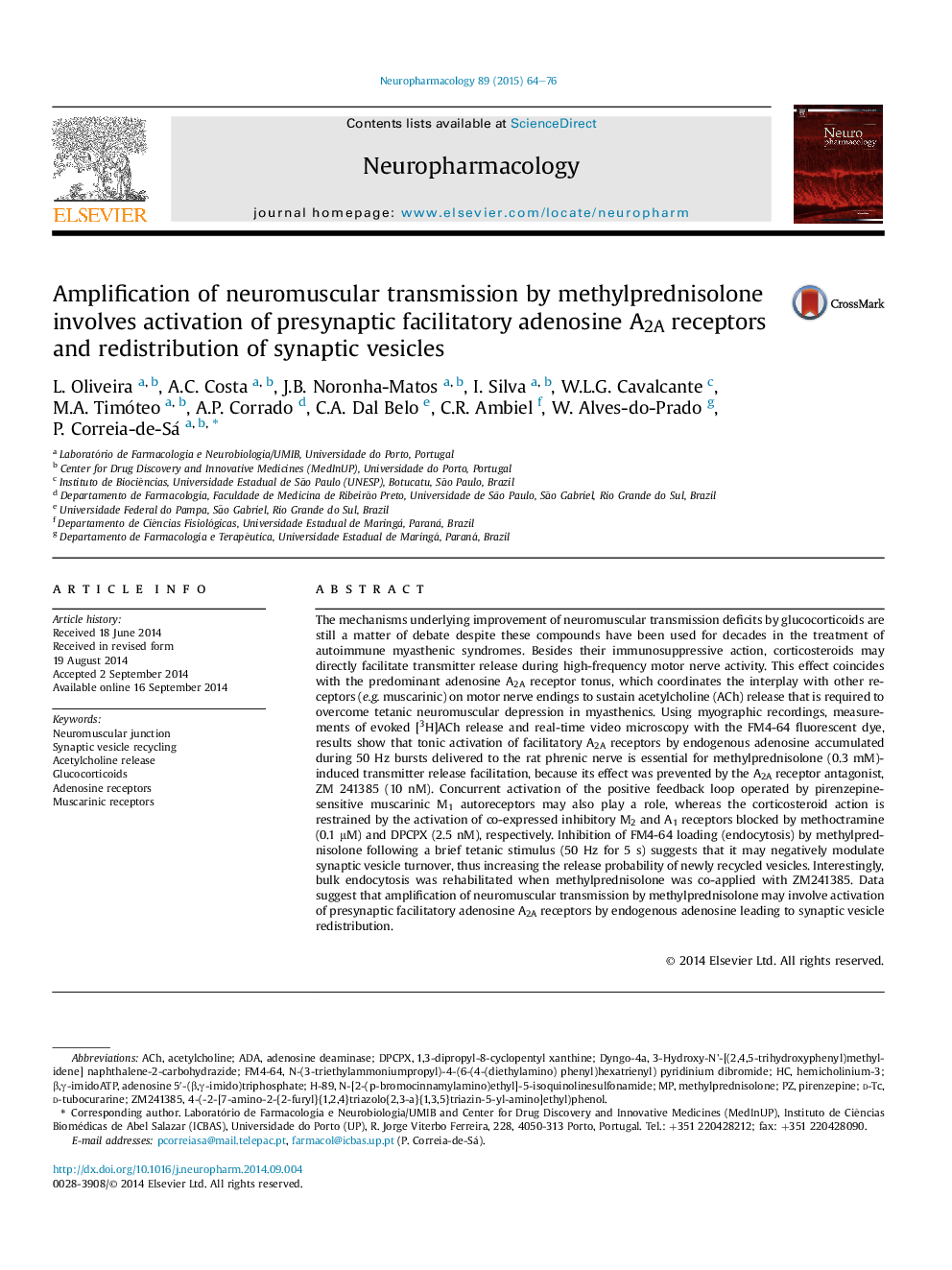| کد مقاله | کد نشریه | سال انتشار | مقاله انگلیسی | نسخه تمام متن |
|---|---|---|---|---|
| 5814254 | 1556625 | 2015 | 13 صفحه PDF | دانلود رایگان |
عنوان انگلیسی مقاله ISI
Amplification of neuromuscular transmission by methylprednisolone involves activation of presynaptic facilitatory adenosine A2A receptors and redistribution of synaptic vesicles
دانلود مقاله + سفارش ترجمه
دانلود مقاله ISI انگلیسی
رایگان برای ایرانیان
کلمات کلیدی
d-TcPirenzepineDPCPXFM4-64H-89hemicholinium-3ZM241385d-tubocurarine - D-tubocurarineadenosine 5′-(β,γ-imido)triphosphate - آدنزین 5 '- (β، γ-امید) تری فسفاتadenosine deaminase - آدنوزین دآمینازACh - آهNeuromuscular junction - اتصال عصبی عضلانیAcetylcholine - استیل کولینAcetylcholine release - انتشار استیل کولینSynaptic vesicle recycling - بازیافت مجدد سیناپتیس vesicleMethylprednisolone - متیل پردنیزولونADA - وجود داردGlucocorticoids - گلوکوکورتیکوئیدهاMuscarinic receptors - گیرنده های MuscarinicAdenosine receptors - گیرنده های آدنوزین
موضوعات مرتبط
علوم زیستی و بیوفناوری
علم عصب شناسی
علوم اعصاب رفتاری
پیش نمایش صفحه اول مقاله

چکیده انگلیسی
The mechanisms underlying improvement of neuromuscular transmission deficits by glucocorticoids are still a matter of debate despite these compounds have been used for decades in the treatment of autoimmune myasthenic syndromes. Besides their immunosuppressive action, corticosteroids may directly facilitate transmitter release during high-frequency motor nerve activity. This effect coincides with the predominant adenosine A2A receptor tonus, which coordinates the interplay with other receptors (e.g. muscarinic) on motor nerve endings to sustain acetylcholine (ACh) release that is required to overcome tetanic neuromuscular depression in myasthenics. Using myographic recordings, measurements of evoked [3H]ACh release and real-time video microscopy with the FM4-64 fluorescent dye, results show that tonic activation of facilitatory A2A receptors by endogenous adenosine accumulated during 50 Hz bursts delivered to the rat phrenic nerve is essential for methylprednisolone (0.3 mM)-induced transmitter release facilitation, because its effect was prevented by the A2A receptor antagonist, ZM 241385 (10 nM). Concurrent activation of the positive feedback loop operated by pirenzepine-sensitive muscarinic M1 autoreceptors may also play a role, whereas the corticosteroid action is restrained by the activation of co-expressed inhibitory M2 and A1 receptors blocked by methoctramine (0.1 μM) and DPCPX (2.5 nM), respectively. Inhibition of FM4-64 loading (endocytosis) by methylprednisolone following a brief tetanic stimulus (50 Hz for 5 s) suggests that it may negatively modulate synaptic vesicle turnover, thus increasing the release probability of newly recycled vesicles. Interestingly, bulk endocytosis was rehabilitated when methylprednisolone was co-applied with ZM241385. Data suggest that amplification of neuromuscular transmission by methylprednisolone may involve activation of presynaptic facilitatory adenosine A2A receptors by endogenous adenosine leading to synaptic vesicle redistribution.
ناشر
Database: Elsevier - ScienceDirect (ساینس دایرکت)
Journal: Neuropharmacology - Volume 89, February 2015, Pages 64-76
Journal: Neuropharmacology - Volume 89, February 2015, Pages 64-76
نویسندگان
L. Oliveira, A.C. Costa, J.B. Noronha-Matos, I. Silva, W.L.G. Cavalcante, M.A. Timóteo, A.P. Corrado, C.A. Dal Belo, C.R. Ambiel, W. Alves-do-Prado, P. Correia-de-Sá,